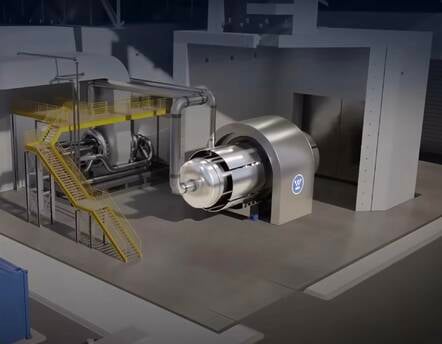The new nuclear age of small modular reactors may not have materialized yet, but that's not stopping the US Department of Energy from getting to work on even smaller, more modular reactors with a couple of new commercial partners.
Earlier this month, the DoE conditionally selected Westinghouse's trailer-sized eVinci test reactor and Radiant's Kaleidos unit to conduct the first fueled microreactor experiments at its Demonstration of Microreactor Experiments (DOME) facility at Idaho National Laboratory.
These experimental units are really, really small compared to other reactors, with self-contained designs from both companies no larger than a semi-truck trailer. The DOME project considers anything under 50 MW of power to be a microreactor; the eVinci is designed to only produce 5 megawatts, and the Kaleidos is limited to just 1.2 megawatts of electrical power output.
For perspective, the average US home only consumes around 30 kWh of electricity per day - so even 1.2 MW is enough for a lot of homes.
Microreactors are one step down from the small modular reactors proposed by startups like Oklo and NuScale. The Nuclear Regulatory Commission (NRC) approved NuScale's original 50 MWe SMR design in February 2023 and its uprated 77 MWe module in May 2025, but no commercial units have yet broken ground. A traditional full-sized nuclear power plant, meanwhile, averages 1 gigawatt of power output - a whopping 833 times the power of a Kaleidos microreactor.
With that in mind, the DoE hopes microreactors could be used to power small, remote sites, with an eVinci described as a possible power source for a remote datacenter. The Radiant Kaleidos, meanwhile, is described as an alternative to a diesel generator, being a similar tractor-trailer-mounted size while being able to operate for five years without needing refueling.

Concept art of a Westinghouse eVinci microreactor
"Microreactors will play a big role in expanding the use of nuclear power in the United States," said Mike Goff, the Acting Assistant Secretary for Nuclear Energy. "These DOME experiments will test new reactor designs that will be counted on in the future to reliably power our homes, military bases, and mission critical infrastructure."
DOME itself is being built out of the remnants of the retired Experimental Breeder Reactor II system in Idaho, meaning it'll be housed in a facility that's already been used to securely contain experimental nuclear projects.
As "the first microreactor test bed in the world," according to the DoE, DOME will be testing new designs for some of the smallest nuclear power reactors in the world - sure to be a risky bet and needing some good protection.
- Energy buffs give small modular reactors a gigantic reality check
- Amazon, Meta, Google sign pledge to triple nuclear power capacity by 2050
- Canada OKs construction of first licensed teeny atomic reactor
- AI datacenters want to go nuclear. Too bad they needed it yesterday
The eVinci, according to the DoE, will use a "heat-pipe cooled" design to produce up to five megawatts of power for eight years without the need for refueling. The Kaleidos, meanwhile, will rely on a high-temperature gas-cooled reactor design, the DoE says.
DOME is designed to be up and running by early 2026 with plans for the experiments to operate one at a time for six months.
Neither Westinghouse nor Radiant's designs have yet been certified for general construction by the NRC, but the DoE tests are a small first step in that direction.
"Data collected from the experiments will be used to commercialize each reactor technology," the DoE said of the DOME project's planned microreactor runs. ®
.png)




